| Pages:
1
..
45
46
47
48
49
..
68 |
Laboratory of Liptakov
International Hazard
    
Posts: 1387
Registered: 2-9-2014
Location: Technion Haifa
Member Is Offline
Mood: old jew
|
|
pictures
Huuh. This is the art of high energy. In the gallery, Christie's sold a lot worse images. Much worse, but for millions of dollars. Send them this
picture. :-) Dr. Liptakov
|
|
|
nux vomica
Hazard to Others
  
Posts: 267
Registered: 18-7-2013
Member Is Offline
Mood: No Mood
|
|
Quote: Originally posted by Laboratory of Liptakov  |
Huuh. This is the art of high energy. In the gallery, Christie's sold a lot worse images. Much worse, but for millions of dollars. Send them this
picture. :-) Dr. Liptakov |
Thanks, it is amazing to think how much energy is forced so quickly through the target but it still looks like the jet delicately pulsed through the
steel.
I dont think you can claim you are a artist to mr plod when he is examining your artistic folio.  nuxy nuxy
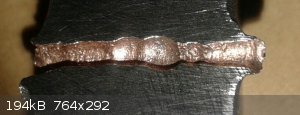
[
[Edited on 24-7-2015 by nux vomica]
|
|
|
nux vomica
Hazard to Others
  
Posts: 267
Registered: 18-7-2013
Member Is Offline
Mood: No Mood
|
|
Tried something different today sill useing my standard setup eg rivnut 1.2grm etn I machined a flat .6mm copper disc 11.5 mm dia and fired it at
10mm m/s at 35mm standoff it only penertrated 3mm o/d of hole was 15 mm cheers nuxy
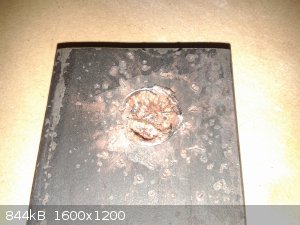 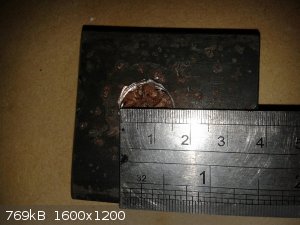 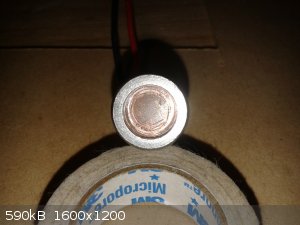
|
|
|
Hennig Brand
International Hazard
    
Posts: 1284
Registered: 7-6-2009
Member Is Offline
Mood: No Mood
|
|
Yeah, without at least a bit of curvature the projectile doesn't narrow and elongate. With curvature the detonation zone hits the apex of the domed
disc (highest point in center) first accelerating it to high velocity long before the detonation zone makes it to the bottom outer edge of the domed
liner (is the same for Munroe effect shaped charges as well). The different in relative velocity and mass difference going from the inside to the
outer edge of the liner generates forces which stretch the liner into a narrower more elongated shape which is much more capable of penetration.
Interesting that the hole diameter, in this flat liner test, is so much larger than the initial liner diameter.
"A risk-free world is a very dull world, one from which we are apt to learn little of consequence." -Geerat Vermeij
|
|
|
nux vomica
Hazard to Others
  
Posts: 267
Registered: 18-7-2013
Member Is Offline
Mood: No Mood
|
|
Quote: Originally posted by Hennig Brand  | | Yeah, without at least a bit of curvature the projectile doesn't narrow and elongate. With curvature the detonation zone hits the apex of the domed
disc (highest point in center) first accelerating it to high velocity long before the detonation zone makes it to the bottom outer edge of the domed
liner (is the same for Munroe effect shaped charges as well). The different in relative velocity and mass difference going from the inside to the
outer edge of the liner generates forces which stretch the liner into a narrower more elongated shape which is much more capable of penetration.
Interesting that the hole diameter, in this flat liner test, is so much larger than the initial liner diameter. |
I'm still not happy with the result hennig I didnt have the liner flush with the outside of the rivnut I think the flared edge on the rivnut
interfered with the forces acting on the liner as the flare was in front of it and also there is a impact ring where the S/S flare hit the target so
the flare and copper liner must have traveled forward , I am going to ether add more etn or a spacer to get the liner flush with the outside of the
rivnut.
Cheers nuxy
Edit tried with liner flush gave a smaller dia impact mark and penertrated 4mm at deepest point of impact might start slowly curving liner to see what
happens.
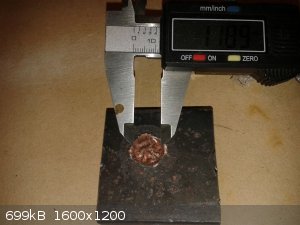
[Edited on 28-7-2015 by nux vomica]
|
|
|
franklyn
International Hazard
    
Posts: 3026
Registered: 30-5-2006
Location: Da Big Apple
Member Is Offline
Mood: No Mood
|
|
The topic heading ' Unconventional Shaped Charges ' judging by the very conventional ones thus seen here seems has
been taken to mean ' improvised ' or not of commercial manufacture. I"M NOT CRITICIZING IT , experimental results posted add to the base of
knowledge. I had this passing thought. A ( H.E.P.) High Explosive Plastic anti armor round consists of a plastic explosive composition that is spread
on impact into a pie shape against the armor. Used against homogeneous armor ( composite interferes ) a shock wave travels through to the interior ,
spalling there a pie sized weight of armor. My thought is how might armor behave if the interface with the
explosive is patterned or corrugated with ridges or pockets , etcetera. I'm not talking about the surface of the armor itself , rather
discrete repeating depressions which are in the explosive's surface. Think of an ice cube tray filled with
explosive and the bottom laid against the armor substrate. The intervals having standoff will by Munroe effect cut a pattern of regular deep channels
into the armor. The idea then is that partially perforated in this way , the armor section is effectively made thinner and therefore possibly
be completely blown inward , making a very large opening. Does anyone know of any investigation or related study of this notion.
In the picture of the ice cube tray the underside is cris crossed with channels which will act like linear shaped charges. These will cut that same
pattern deeply into the armor. The unperforated armor beyond the depth of the cuts is thinner and more yielding to the force of the explosion.
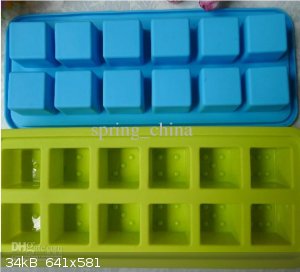
These may have been posted before I don't know , found by googling - explosive wave shaping
Explosive Loading of Metals & Related Topics
www.dtic.mil/dtic/tr/fulltext/u2/b102693.pdf
Imaging detonation waves for wave shaper
www.dtic.mil/dtic/tr/fulltext/u2/a513564.pdf
Detonation wave conference
www.dtic.mil/dtic/tr/fulltext/u2/128529.pdf
Method to Increase Tip Velocity of a Shaped Charge Jet
www.mater.upm.es/isb2007/Proceedings/PDF/Volume_1/Vol.I(14)W...
Stopping Power of Explosive Reactive Armours
http://www.cryptocomb.org/Stopping%20Power%20of%20Explosive%...
Patent resource
http://patents.justia.com/patents-by-us-classification/102/4...
Interesting site for the clarity of explanation of nuclear porn
http://nuclear-knowledge.com/explosivelenses.php
Thermonuclear lenses
http://books.google.com/books?id=B7RV_vASz0EC&lpg=PA311&...
[Edited on 3-8-2015 by franklyn]
Techniques to Disrupt, Deviate and Seize Control of
an Internet Forum In case you wonder W T F ! is going on here
?
www.zerohedge.com/contributed/2012-10-28/cointelpro-techniques-dilution-misdirection-and-control-internet-forum https://web.archive.org/web/20120814124000/www.washingtonsblog.com/2012/08/the-15-rules-of-internet-disinformation.html
___________________________________________________________________________________________________________________
___________________________________________________________________________________________________________________
___________________________________________________________________________________________________________________
|
|
|
nux vomica
Hazard to Others
  
Posts: 267
Registered: 18-7-2013
Member Is Offline
Mood: No Mood
|
|
Quote: Originally posted by franklyn  | | The topic heading ' Unconventional Shaped Charges ' judging by the very conventional ones thus seen here seems has
been taken to mean ' improvised ' or not of commercial manufacture. I"M NOT CRITICIZING IT , experimental results posted add to the base of
knowledge. |
Franklyn I think we need to start another sticky for conventional style shaped charges so if there was a seperate sticky im sure people would use
there judgment to post in the right thread, or maybe rename the sticky to conventional and non conventional shaped charges. nuxy
[Edited on 3-8-2015 by nux vomica]
|
|
|
Hennig Brand
International Hazard
    
Posts: 1284
Registered: 7-6-2009
Member Is Offline
Mood: No Mood
|
|
Franklyn, sounds like you are talking about "High-explosive squash head" (HESH) rounds. It is not classified as a shaped charge I don't think but it
is effective against armor.
https://en.wikipedia.org/wiki/High-explosive_squash_head
Here is a good demonstration, start watching at 22:30.
https://www.youtube.com/watch?v=6Z9o5oPMWss
<iframe sandbox width="560" height="315" src="https://www.youtube.com/embed/6Z9o5oPMWss" frameborder="0" allowfullscreen></iframe>
Edit:
I see that you are talking about something related but different now that I have read your post more carefully.
[Edited on 3-8-2015 by Hennig Brand]
"A risk-free world is a very dull world, one from which we are apt to learn little of consequence." -Geerat Vermeij
|
|
|
VladimirLem
Hazard to Others
  
Posts: 204
Registered: 24-5-2010
Member Is Offline
Mood: Have no fear <Vlad> is here.
|
|
you are talking about HESH...
You have to know, these charges doesnt penetrate the armor like a shaped charge or an EFP...the enormous pressure on the surface is that high, that
the armor rear side (inside of the "tank") gets "brittle" and is bounced off into the tank (with high speed and having alot of kinetic energy)...the
armour plate still is not penetrated.
I highly doubt there would be an advantage if you would make the explosive with a higher surface (shapedcharge-like) to the target...well, the
projectiles inside the "tank" would be more, but with less energy and if the armor is too thick, no projectile will be build inside the tank. to this
comes that the shock have to directly hit the target...mini-shapedcharges would "destroy" the surface, but wouldnt (i guess) improve the power of the
shockwave nessesary for the HESH projectile...
I really like HESH...saw a video once...very impressive...i was like "No way, dis wont penetrate"...was right, but....WELLLL....
HESH is 50th...maybe 60th and really fun to do, i guess, but against DU/ceramic-armor its completely useless today
|
|
|
nux vomica
Hazard to Others
  
Posts: 267
Registered: 18-7-2013
Member Is Offline
Mood: No Mood
|
|
Efp success
I have been trying to find the point where my charges turn into a efp , I changed the angles of the cones by 10 ° starting at 120° still a small jet
hole ,130° transition small hole but copper spatter was looking like a efp probably should do this one again, 140° definate efp target is 6mm mild
steel at 100 mm standoff charge is standard ebw 1.2 etn at 3500 volts.
I also found the carrot in the wood block below more steel than copper must have had only enough energy to just punch through the 6 mm cheers nuxy.
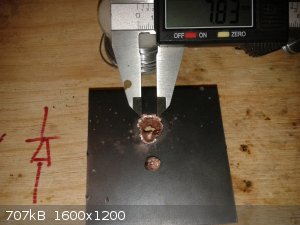 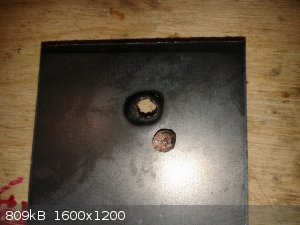 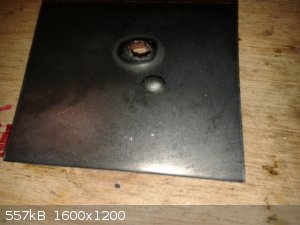
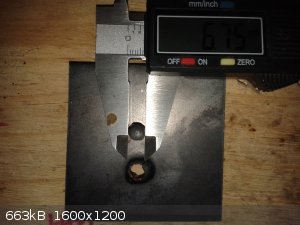
[Edited on 8-8-2015 by nux vomica]
|
|
|
Hennig Brand
International Hazard
    
Posts: 1284
Registered: 7-6-2009
Member Is Offline
Mood: No Mood
|
|
Very interesting test. That 140 degree value agrees with what I have seen in the literature a few times as well.
"A risk-free world is a very dull world, one from which we are apt to learn little of consequence." -Geerat Vermeij
|
|
|
nux vomica
Hazard to Others
  
Posts: 267
Registered: 18-7-2013
Member Is Offline
Mood: No Mood
|
|
Thanks I didnt have any fixed ideas of angles I started with the angle closest to the cone hight of the cylindrical liners .
I have uploaded the120° and 130° test plates for comparison nuxy.
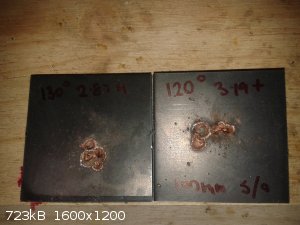 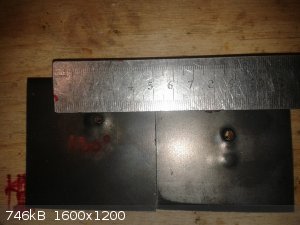
[Edited on 9-8-2015 by nux vomica]
|
|
|
greenlight
National Hazard
   
Posts: 737
Registered: 3-11-2014
Member Is Offline
Mood: Energetic
|
|
EFP IMPROVEMENT
I performed another test with an EFP trying to drop the amount of explosive used and use PE instead of the usual pressed powder.
The explosive was 79% PETN, 5% RDX, 15% polybutene, 1% motor oil.
The flyer plate was a 0.9mm copper disc 30mm in diameter.
Casing was a 35mm long PVC pipe.
Explosive weight was 16 grams, almost half the amount I was using with powder.
The target was a 10mm or 3/8 inch steel plate.
Result is a complete penetration leaving a very clean hole with little spalling around it.
Very happy with the plastic as a main charge, makes loading and det insertion much easier too
[Edited on 10-8-2015 by greenlight]
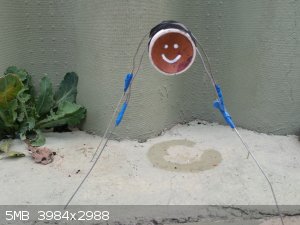 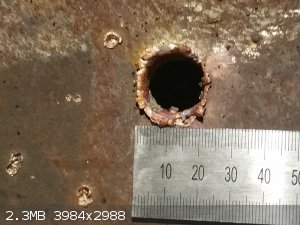 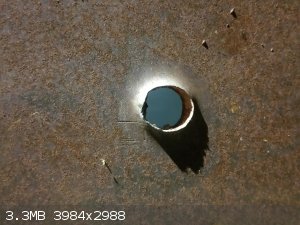
|
|
|
nux vomica
Hazard to Others
  
Posts: 267
Registered: 18-7-2013
Member Is Offline
Mood: No Mood
|
|
Quote: Originally posted by greenlight  | I performed another test with an EFP trying to drop the amount of explosive used and use PE instead of the usual pressed powder.
The explosive was 79% PETN, 5% RDX, 15% polybutene, 1% motor oil.
The flyer plate was a 0.9mm copper disc 30mm in diameter.
Casing was a 35mm long PVC pipe.
Explosive weight was 16 grams, almost half the amount I was using with powder.
The target was a 10mm or 3/8 inch steel plate.
Result is a complete penetration leaving a very clean hole with little spalling around it.
Very happy with the plastic as a main charge, makes loading and det insertion much easier too
|
Sweeeet you would have to be happy with that looks like the efp held together nicely,went through like a hot knife through butter. nuxy
[Edited on 10-8-2015 by nux vomica]
|
|
|
greenlight
National Hazard
   
Posts: 737
Registered: 3-11-2014
Member Is Offline
Mood: Energetic
|
|
Yes, much better effect than before.
I think I will see if it can penetrate 3/4 inch steel next.
|
|
|
nux vomica
Hazard to Others
  
Posts: 267
Registered: 18-7-2013
Member Is Offline
Mood: No Mood
|
|
How far away was mr smiley face from the ten mm plate greenlight 16 grams must have kicked him in the arse pretty hard.
|
|
|
greenlight
National Hazard
   
Posts: 737
Registered: 3-11-2014
Member Is Offline
Mood: Energetic
|
|
Yes it did haha..
Standoff was 60 cm exactly.
[Edited on 10-8-2015 by greenlight]
|
|
|
nux vomica
Hazard to Others
  
Posts: 267
Registered: 18-7-2013
Member Is Offline
Mood: No Mood
|
|
You didnt catch him after he went through the plate ?
Intresting to see how far 16grams will punch through now you have got it all worked out.. nuxy
|
|
|
greenlight
National Hazard
   
Posts: 737
Registered: 3-11-2014
Member Is Offline
Mood: Energetic
|
|
I had the plate against a tree but it penetrated just to the left of it it so I couldn't retrieve it.
I'm going to try and catch one that hasn't been deformed soon. I just have to think of an effective way to stop it without damaging it.
|
|
|
nux vomica
Hazard to Others
  
Posts: 267
Registered: 18-7-2013
Member Is Offline
Mood: No Mood
|
|
Quote: Originally posted by greenlight  | I had the plate against a tree but it penetrated just to the left of it it so I couldn't retrieve it.
I'm going to try and catch one that hasn't been deformed soon. I just have to think of an effective way to stop it without damaging it.
|
Do mythbusters use a stack of phone books didnt they stop a 50 cal bullet with them.
[Edited on 10-8-2015 by nux vomica]
|
|
|
greenlight
National Hazard
   
Posts: 737
Registered: 3-11-2014
Member Is Offline
Mood: Energetic
|
|
I think that the speed the slug is travelling will cause it to deform still.
There is a test I found on the internet trying to develop EFPs to take out underwater mines where they were firing them into water and that was
causing them to break up a lot.
I also read somewhere about using a pipe filled with sawdust and one following behind filled with water. The sawdust should slow it down enough that
it doesn't deform when it hits the water.
|
|
|
Laboratory of Liptakov
International Hazard
    
Posts: 1387
Registered: 2-9-2014
Location: Technion Haifa
Member Is Offline
Mood: old jew
|
|
catch slug
Well, nice piece work. Clear hole, thats very good. Catching slug? I trying one more time. But I catch only 40% from flyer plate. Sawdust and water is
good idea. I estimate 2 meter sawdust. I estimate using 2x plast bag with sawdust 1m long, and 3x plast container ( thick 25 cm) 5l water. Liptakov.
|
|
|
greenlight
National Hazard
   
Posts: 737
Registered: 3-11-2014
Member Is Offline
Mood: Energetic
|
|
Thankyou..
I was thinking of using a 2 metre long pipe filled with sawdust and another 1 metre long pipe filled with water attached behind it.
This should be enough to stop an EFP of the same size as the last test without damaging the slug or losing any of it.
|
|
|
Laboratory of Liptakov
International Hazard
    
Posts: 1387
Registered: 2-9-2014
Location: Technion Haifa
Member Is Offline
Mood: old jew
|
|
depth
Well, I look forward to the results. The question: I no seen deflection depth of the liner 30mm diameter/ Cu 0,9mm. Important thing. Dr. Liptakov,
all what flying.
|
|
|
greenlight
National Hazard
   
Posts: 737
Registered: 3-11-2014
Member Is Offline
Mood: Energetic
|
|
If you mean the depth of curvature of the liner it was 5 mm (16.6% of liner diameter).
|
|
|
| Pages:
1
..
45
46
47
48
49
..
68 |